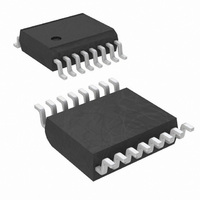LM83CIMQA/NOPB National Semiconductor, LM83CIMQA/NOPB Datasheet - Page 9

LM83CIMQA/NOPB
Manufacturer Part Number
LM83CIMQA/NOPB
Description
IC TEMP SENSOR DIGITAL 16-SSOP
Manufacturer
National Semiconductor
Type
Sensorsr
Datasheet
1.LM83CIMQANOPB.pdf
(20 pages)
Specifications of LM83CIMQA/NOPB
Function
Hardware Monitor
Topology
ADC (Sigma Delta), Comparator, Register Bank
Sensor Type
External & Internal
Sensing Temperature
-40°C ~ 125°C, External Sensor
Output Type
I²C™/SMBus™
Output Alarm
Yes
Output Fan
No
Voltage - Supply
3 V ~ 3.6 V
Operating Temperature
-40°C ~ 125°C
Mounting Type
Surface Mount
Package / Case
16-SSOP
Ic Output Type
Digital
Sensing Accuracy Range
± 1°C
Temperature Sensing Range
-40°C To +125°C
Supply Current
800µA
Supply Voltage Range
3V To 3.6V
Resolution (bits)
8bit
Rohs Compliant
Yes
Lead Free Status / RoHS Status
Lead free / RoHS Compliant
Other names
*LM83CIMQA
*LM83CIMQA/NOPB
LM83CIMQA
*LM83CIMQA/NOPB
LM83CIMQA
Available stocks
Company
Part Number
Manufacturer
Quantity
Price
Company:
Part Number:
LM83CIMQA/NOPB
Manufacturer:
NEC
Quantity:
2 500
Company:
Part Number:
LM83CIMQA/NOPB
Manufacturer:
TI
Quantity:
400
Part Number:
LM83CIMQA/NOPB
Manufacturer:
NS/国半
Quantity:
20 000
1.0 Functional Description
Register flags are updated at the completion of a conversion,
which occurs approximately 60 ms after a temperature diode
is sampled. INT is deactivated when the Status Register,
containing the set bit, is read and a temperature reading is
less than or equal to it’s corresponding HIGH setpoint, as
shown in Figure 4 . Figure 5 shows a simplified logic diagram
for the INT output and related circuitry.
bit is located.
The INT output can be disabled by setting the INT mask bit,
D7, of the configuration register. INT can be programmed to
be active high or low by the state of the INT inversion bit, D1,
in the configuration register. A “0” would program INT to be
active low. INT is an open-drain output.
1.3 T_CRIT_A OUTPUT and T_CRIT LIMIT
T_CRIT_A is activated when any temperature reading is
greater than the limit preset in the critical temperature set-
point register (T_CRIT), as shown in Figure 6 . The Status
Registers can be read to determine which event caused the
alarm. A bit in the Status Registers is set high to indicate
which temperature reading exceeded the T_CRIT setpoint
temperature and caused the alarm, see Section 2.3 .
*
Note: Status Register Bits are reset by a read of Status Register where
FIGURE 5. INT output related circuitry logic diagram
FIGURE 4. INT Temperature Response Diagram with
D2RHS and D3RHS set to 127˚C.
(Continued)
DS101058-14
DS101058-21
9
Local and remote temperature diodes are sampled in se-
quence by the A/D converter. The T_CRIT_A output and the
Status Register flags are updated at the completion of a con-
version. T_CRIT_A and the Status Register flags are reset
only after the Status Register is read and if a temperature
conversion is below the T_CRIT setpoint, as shown in Figure
6 . Figure 7 shows a simplified logic diagram of the
T_CRIT_A and related circuitry.
*
bit is located.
Located in the Configuration Register are the mask bits for
each temperature reading, see Section 2.5 . When a mask bit
is set, its corresponding status flag will not propagate to the
T_CRIT_A output, but will still be set in the Status Registers.
Setting all four mask bits or programming the T_CRIT set-
point to 127˚C will disable the T_CRIT_A output.
1.4 POWER ON RESET DEFAULT STATES
LM83 always powers up to these known default states:
1. Command Register set to 00h
2. Local Temperature set to 0˚C
FIGURE 6. T_CRIT_A Temperature Response Diagram
Note: Status Register Bits are reset by a read of Status Register where
with remote diode 1 and local temperature masked.
FIGURE 7. T_CRIT_A output related circuitry logic
diagram
www.national.com
DS101058-20
DS101058-6












